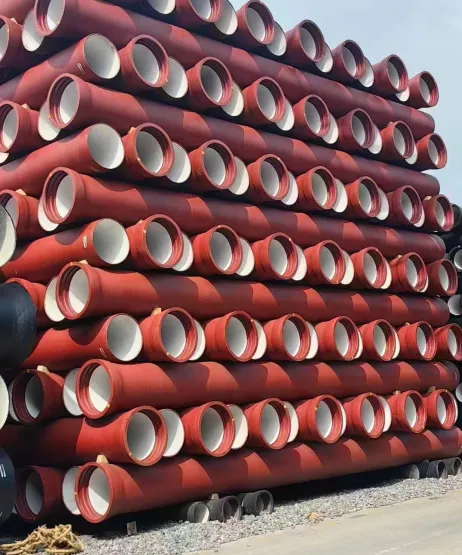Ductile iron pipe (DIP) has become the backbone of modern infrastructure, combining unparalleled durability with cost efficiency. Accounting for 68% of the global water pipe market (Global Pipe Market Report 2024), DIP outperforms alternatives like PVC, steel, and traditional cast iron in high-stress environments.

1. Municipal Water Supply Systems
Primary Applications
-
Transmission Mains:
-
Used for high-pressure (PN10-PN40 per ISO 2531) potable water distribution.
-
Example: Los Angeles Department of Water and Power replaced 90% of aging steel pipes with DIP to reduce leakage from 15% to 2%.
-
-
Fire Hydrant Networks:
-
Withstands 350 psi surge pressures (AWWA C151), critical during emergency firefighting.
-
Why DIP Over Alternatives?
| Parameter | Ductile Iron Pipe | PVC Pipe | Steel Pipe |
|---|---|---|---|
| Lifespan | 100+ years | 50-75 years | 50-100 years (with coating) |
| Break Rate | 2 breaks/100 km/year | 5 breaks/100 km/year | 4 breaks/100 km/year |
| Cost per Mile (50yr) | $1.2M | $1.8M (replacements included) | $1.5M (maintenance heavy) |
Case Study:
Singapore’s PUB achieved 99.9% water network reliability using DIP with zinc-EPOXY coatings, complying with WHO GWD 2025 standards.
2. Wastewater & Sewage Management
Key Use Cases
-
Gravity Sewers:
-
Resists hydrogen sulfide corrosion (pH 1.5-12) via V-Bio® enhanced polyethylene linings (EN 598:2022).
-
-
Pumping Stations:
-
Handles abrasive sludge with 3mm wear allowance per ISO 2531, unlike brittle PVC.
-
Regional Standards
| Region | Standard | DIP Requirement |
|---|---|---|
| European Union | EN 598:2022 | Minimum 100-year design life |
| United States | AWWA C151 | 24” diameter for trunk sewers |
| Middle East | GS 1025:2020 (GCC) | Sand abrasion resistance ≥5mm/50 years |
Project Highlight:
Egypt’s New Administrative Capital uses DIP in 120 km of sewage networks to combat desert soil corrosion.
3. Industrial Applications
A. Mining & Mineral Processing
-
Slurry Transport:
-
DIP’s 500 MPa tensile strength (AS/NZS 2280) surpasses HDPE’s 25 MPa, reducing pipe whip risks.
-
Coating: Aluminized epoxy for pH 2-14 resistance.
-
-
Dewatering Systems:
-
Handles 10 m/s flow velocity vs. steel’s 6 m/s limit (ISO 21003).
-
B. Oil & Gas
-
Produced Water Disposal:
-
Withstands H₂S concentrations up to 10,000 ppm (NACE MR0175).
-
UAE’s ADNOC uses DIP for 80°C brine injection wells.
-
C. Power Generation
-
Cooling Water Circuits:
-
Thermal expansion coefficient: 11.5 µm/m·°C (DIP) vs. 23 µm/m·°C (steel), minimizing joint stress.
-
Case: India’s Mundra Thermal Plant uses DIP to handle 45°C seawater cooling.
-
4. Agricultural Irrigation
Large-Scale Farming Solutions
-
Center Pivot Systems:
-
Buried DIP (Class 50 per ISO 2531) resists UV degradation and farm machinery loads.
-
-
Drip Irrigation Mains:
-
Cement-mortar lining maintains C=140 hydraulic efficiency for 50+ years (AS 4020).
-
Cost-Benefit Analysis
| Factor | Ductile Iron Pipe | HDPE Pipe |
|---|---|---|
| Rodent Damage | Immune | High risk |
| UV Resistance | Lifetime (buried) | 15-year UV stabilization |
| Installation Speed | 200m/day (trenching) | 500m/day (plowing) |
| 30-Year Total Cost | $18,000/km | $22,000/km |
UN FAO Data: DIP-based irrigation boosts crop yields by 12% vs. PVC in alkaline soils.
5. Specialized Infrastructure Projects
A. Earthquake-Prone Zones
-
Seismic Design:
-
Flexible push-on joints allow 5° deflection (EN 545:2010), surviving 0.8g PGA (ICC-ES ESR-1195).
-
Japan’s Tokyo Waterworks uses DIP with SFRM joints for Zone 7 seismic compliance.
-
B. Coastal & Corrosive Environments
-
Protection Systems:
-
3-layer polyethylene (3LPE) coating + magnesium anodes per ISO 21809-1.
-
Example: Qatar’s Lusail City coastal network uses 3LPE DIP to resist 5% salinity groundwater.
-
C. Tunneling & Trenchless Tech
-
Microtunneling:
-
DIP’s 18m segment lengths reduce joints vs. 6m concrete pipes.
-
Germany’s Stuttgart 21 project achieved 2.5m/day advance rates with DIP.
-
6. Global Market Adoption Trends
| Region | DIP Market Share | Key Driver |
|---|---|---|
| North America | 75% of water mains | AWWA C151 compliance |
| Europe | 60% (EU Water Framework Directive) | EN 545/EN 598 standards |
| Asia-Pacific | 45% (growing at 8.2% CAGR) | Smart city investments |
| Middle East | 80% of mega-project pipelines | Desert soil corrosion resistance |
The versatility of ductile iron, combined with its superior mechanical properties, ensures its continued use across diverse industries, meeting the demanding requirements of various applications.

